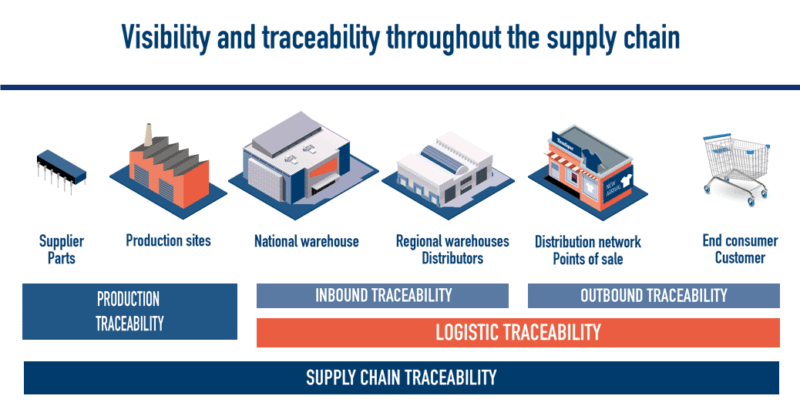


E-commerce has created new expectations for the traceability of B2B flows: we are no longer solely concerned with controlling or optimising transport costs. We have embarked on a process of improving visibility on internal and external flows.
And many benefits emanate from the implementation of an upstream and downstream traceability system for manufacturers and distributors: quality of customer service, rapid identification of hazards throughout the production and transport chains, response to increasingly strict and numerous regulatory constraints.

A multitude of stakeholders coexist on this aspect of the chain: suppliers, inspection company, agents, state agencies….
Traceability is therefore essential but also more complex. In recent years, several examples have demonstrated the need for good batch traceability. In the event of a problem, it makes it possible to immediately identify all the flows associated with the products, based on a batch reference available in a distribution network. Otherwise, a whole set of shipping periods must be removed. This is achieved by applying a precautionary principle that is often broad and costly.
Traceability also offers increased transparency on the plants and makes it possible to trace the origin of production (sites, audits). Today, finished products are ordered from factories around the world. It is therefore necessary to have traceability on suppliers, plants and production sites. This traceability can also be exercised with tier 2 suppliers to control the supply of components to the assembler supplier. Traceability offers this reactivity and allows you to be more reactive, cancel an order, stop a production cycle, have your products re-inspected or even modify an engineering process… From end to end of the chain, it thus improves consumer protection.
Indeed, traceability also plays an important role in the upstream and downstream transport phases. A traced product flow brings many benefits; facilitating receipt in warehouses, immediate determination of the floating stock, information to recipients, improved planning, facilitation of inventories and withdrawals…
The challenge is increasingly to be able to combine the 2 production and transport traceability to move up the entire chain on the basis of a product defect reported by a process stakeholder.
These traceability needs also push the company to evolve technologically. Connected objects, RFID, geofencing, mobile applications, collaborative portals… all these technologies make it possible to trace from manufacturing at the supplier’s premises to the checkout.
Today, we see that every new supply chain information systems project includes a chapter on connectivity; l’EDI, visibility, traceability. This has become essential, and we even see logistics traceability projects driven by marketing or customer service.
And to have a complete view of its supply chain, however fragmented or complex it may be, it is necessary to rely on systems. Traceability is one of them, even if some limits still remain. Its entry cost, which is nevertheless tending to become more democratic with the deployment of SAAS offers, the need to have its partner ecosystem production / transport able to manage these aspects. But also consumer protection issues (an RFID tag on a garment does not spontaneously deactivate itself) or a lack of maturity of some promising subjects in logistics, especially connected objects.

